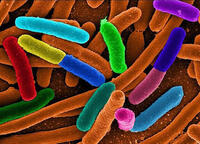Disinfection Overview
Traditional cleaning and disinfecting chemicals such as bleach and quaternary ammoniums are known to cause and exacerbate asthma, chronic obstructive pulmonary disease (COPD), and respiratory irritation. The incidence of occupational asthma (asthma caused by workplace exposures) is high in cleaning professionals, health care workers, and others with frequent exposure to cleaning and disinfecting chemicals. However, effective disinfection in healthcare settings, schools, the food service and production industries is critical for preventing transmission of infectious disease, especially in vulnerable populations such as children and those who are immunocompromised.
Safer disinfectants are of great interest, but effectiveness cannot be sacrificed. Many purportedly safer approaches to cleaning and disinfection exist, based on a variety of approaches including improved physical removal, natural products such as plant essential oils, steam, activated water,
antimicrobial incorporation into materials such as fabrics and colors. Few of these alternatives have been scientifically evaluated for their ability to kill infectious agents. Those that have been tested have usually been tested following EPA guidelines, which specify testing limited microorganisms under ideal laboratory conditions. In real world conditions, there are many variables, such as different surface materials, irregular surfaces and the presence of soil which may inactivate or physically block a disinfectant. In addition, many users may or may not follow the product instructions correctly, leading to inadequate contact times and incorrect dilutions. Research into the effectiveness of alternative disinfectants has the potential to significantly impact rates of occupational asthma and the overall health and safety of anyone with a respiratory disease, as well as those who are at risk for infection.
Disinfectant performance evaluations in real world settings require a rapid, reliable means of comparing pre- and post-cleaning surface contamination. Several devices are commercially available for monitoring surface hygiene, based on measurement of adenosinetriphosphate (ATP) by bioluminescence. ATP is a molecule found in all cells, living and recently dead, including bacterial, fungal, human, animal, and plant cells. It seems logical that the removal of ATP from a surface should correspond with the removal of biological soil and infectious agents. But the relationship between the quantity of ATP detected and the quantity of cells present is not linear and it is difficult to draw anything but a general conclusion about surface hygiene from ATP measurements. Despite evidence of this non-linear relationship, ATP devices are widely used and frequently over interpreted or misinterpreted, especially in the food industry and by non-scientist facilities managers and cleaning professionals. More research into the performance characteristics of these devices and their appropriate use is needed.
